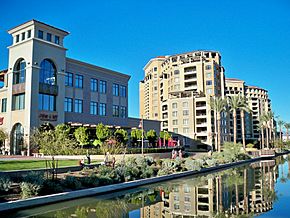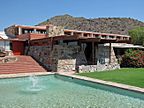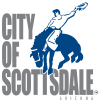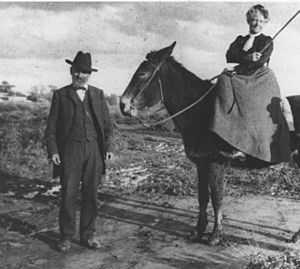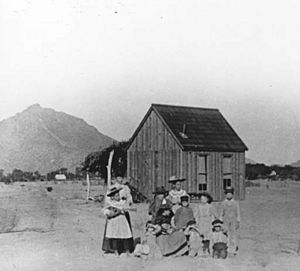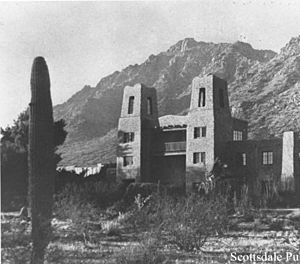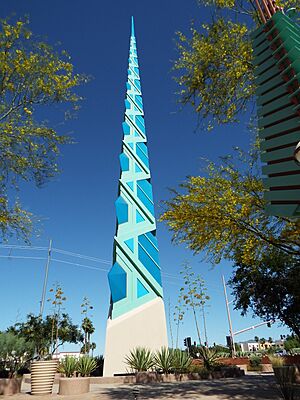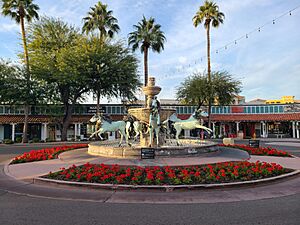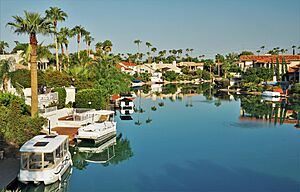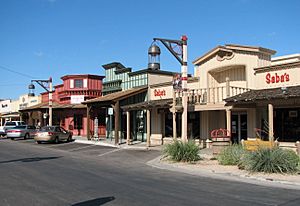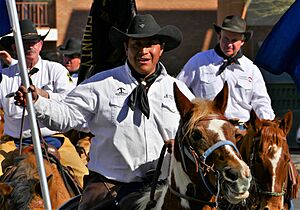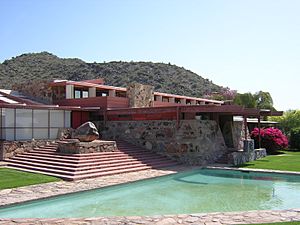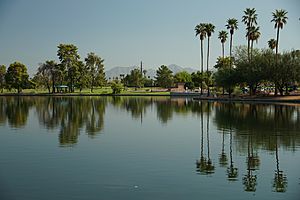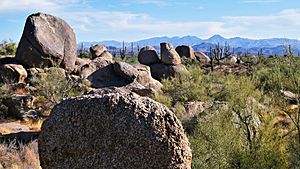Scottsdale, Arizona facts for kids
Quick facts for kids
Scottsdale, Arizona
Vaṣai S-vaṣonĭ
|
|||||
|---|---|---|---|---|---|
|
Clockwise from top: Downtown Scottsdale waterfront, Old Town Scottsdale, and Taliesin West
|
|||||
|
|||||
| Nickname(s):
"The West's Most Western Town" (official)
|
|||||
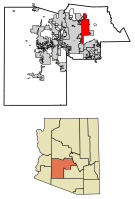
Location in Maricopa County, Arizona
|
|||||
| Country | United States | ||||
| State | Arizona | ||||
| County | Maricopa | ||||
| Incorporated | June 25, 1951 | ||||
| Named for | Winfield Scott | ||||
| Government | |||||
| • Type | Council–manager | ||||
| Area | |||||
| • Total | 184.44 sq mi (477.70 km2) | ||||
| • Land | 184.00 sq mi (476.57 km2) | ||||
| • Water | 0.44 sq mi (1.14 km2) | ||||
| Elevation | 2,165 ft (660 m) | ||||
| Population
(2020)
|
|||||
| • Total | 241,361 | ||||
| • Rank | US: 93rd | ||||
| • Density | 1,311.72/sq mi (506.46/km2) | ||||
| Time zone | UTC−7 (MST (no DST)) | ||||
| ZIP codes |
85250–85264, 85266-85269, 85271
|
||||
| Area code(s) | 480 | ||||
| FIPS code | 04-65000 | ||||
| GNIS ID | 2411845 | ||||
Scottsdale is a city in Arizona, United States. It is located in the eastern part of Maricopa County and is part of the larger Phoenix metropolitan area. The city was named in 1894 after its founder, Winfield Scott. He was a retired chaplain from the U.S. Army.
Scottsdale became an official city in 1951 with about 2,000 people. By 2020, its population had grown to over 241,000. The city's official slogan is "The West's Most Western Town." Over the last 20 years, Scottsdale has become one of the fastest-growing cities in the United States.
The city stretches about 31 miles (50 km) from north to south. It covers an area of about 184.5 square miles (478 km²). Scottsdale is next to Phoenix on the west and the Tonto National Forest to the north. The McDowell Mountains are to its east, and the Salt River is to its south.
Contents
History of Scottsdale
Early Beginnings
Scottsdale was first a village for the Pima people. They called it Vaṣai S-vaṣonĭ, which means "rotting hay." Some Pima people still live in the area today. Many Pima and Maricopa people live in the Salt River Pima-Maricopa Indian Community. This community borders Scottsdale to the south and east.
How Scottsdale Was Founded
In the 1880s, U.S. Army Chaplain Winfield Scott visited the Salt River Valley. He was very impressed by the land and its farming potential. In 1888, he returned with his wife, Helen. They bought 640 acres (2.6 km²) of land where Old Town Scottsdale is now.
Another landowner, Albert G. Utley, planned a city called "Orangedale." He used Scott's land as a border. When a newspaper wrote about his plan, they accidentally called the town "Scottsdale." This mistake brought attention to the area. It convinced Utley to officially name the town "Scottsdale."
In 1896, the first schoolhouse opened in Scottsdale. The first general store and post office followed in 1897. In the early 1900s, many artists and writers moved to the community. The first resort, the Ingleside Inn, opened in 1909. Also in 1909, Cavalliere's Blacksmith Shop opened downtown. The original schoolhouse was replaced by the Little Red Schoolhouse, which is still there today.
Between 1908 and 1933, Scottsdale grew a lot. This was because of the new Granite Reef and Roosevelt dams. It became a small market town, helping local farmers. During World War I, Scottsdale became a big cotton farming area. This boom ended when the war finished.
In 1920, a second resort called the Jokake Inn opened. Its name means "mud house." This building still stands today at the Phoenician Resort.
During the Great Depression, many artists and architects came to Scottsdale. One famous person was Frank Lloyd Wright. In 1937, he bought 600 acres (2.4 km²) of desert land. He built Taliesin West there, which was his winter home and office. Wright's designs have had a lasting impact on buildings in the area.
Scottsdale During World War II
During World War II, Thunderbird II Airfield opened in 1942. It later became Scottsdale Airport. About 5,500 pilot students trained there during the war. Scottsdale also had a German POW (Prisoner of War) camp.
Growth and Development: 1950s–1970s
In 1950, Motorola built a factory in Scottsdale. This was the first of many technology companies to come. Scottsdale officially became a city on June 25, 1951. Its population was about 2,000 people. Malcolm White became the first mayor. The city adopted its motto: "The West's Most Western Town."
Scottsdale grew very quickly in the 1950s, from 2,000 to 10,000 residents. This growth led to building in the Indian Bend Wash area, which was a floodplain. Flooding was a problem, so in 1959, the Maricopa County Flood Control District was formed.
Engineers first suggested building concrete canals to control floods. But local meetings led to a different idea: the "Greenbelt" concept. This plan involved creating green spaces that could also manage floodwaters. The canal plan was rejected in 1965. After a big flood in 1972, work on the Greenbelt project began. It was finished in 1984. Today, the 12-mile (19 km) long Scottsdale Greenbelt connects four city parks with a 25-mile (40 km) bike path.
More Expansion and Growth: 1970s–1980s
The city kept growing in the 1960s and 1970s. By 1970, the population was almost 68,000. Most of the empty land was to the north, so the city expanded in that direction. Scottsdale grew from 5 square miles (13 km²) in 1959 to 62 square miles (160 km²).
Large ranches in the northern part of the city were sold for development. One of the biggest was the McCormick ranch, which was 4,236 acres (17.1 km²). This led to many large, planned communities being built in Scottsdale. These include Scottsdale Ranch (1978), Gainey Ranch (1980), and McDowell Mountain Ranch (1992).
In 1975, the city added the "east Shea" section, increasing its size to 88.6 square miles (229 km²). From 1981 to 1984, Scottsdale added almost 80 more square miles (207 km²).
With all this fast growth, many residents worried about losing the natural desert scenery. In 1991, the McDowell Sonoran Conservancy was created. They worked with developers to set aside the McDowell Mountains as a huge preserve. In 1995, citizens voted to use sales tax money to buy land for this purpose. When finished, the McDowell Sonoran Preserve will be 36,000 acres (146 km²). This is almost one-third of Scottsdale's total land area.
Scottsdale Today
From 2,000 people in 1951, Scottsdale grew to over 241,000 by 2020. It is now Arizona's seventh-largest city. Scottsdale is known for its high quality of life. In 1993, it was named a "Most Livable City."
The Scottsdale Airpark, around the city's airport, has become a major business hub. It has many large and small companies, from light industry to luxury car sales. In the 2000s, the Airpark became one of the top places for jobs in the Phoenix area.
Geography and Environment

Scottsdale is in the Salt River Valley, also known as the "Valley of the Sun." This area is part of the northern Sonoran Desert. The city is about 31 miles (50 km) long and 11.4 miles (18.3 km) wide at its widest point.
Scottsdale shares borders with several other cities. To the west, it borders Phoenix and Paradise Valley. To the north, it borders Carefree and the Tonto National Forest. Tempe is to the south. The Salt River Pima-Maricopa Indian Community also borders Scottsdale to the south and east. The highest point in Scottsdale is Butte Peak, which is 4,890 feet (1,490 m) high.
The city's total area is about 184.4 square miles (477.6 km²). Only a small part, about 0.4 square miles (1.0 km²), is water.
Environmental Concerns
From the 1950s to the 1970s, some factories in Scottsdale used a chemical called trichloroethylene (TCE). In the early 1980s, this chemical was found in Scottsdale's drinking water. The Indian Bend Wash superfund site was then listed for cleanup. Cleanup systems were built by 2006.
In 1969, Scottsdale developed one of the first automated garbage trucks. This made garbage collection much easier and more efficient.
City Layout
Scottsdale is generally divided into four main areas:
- South Scottsdale: This has been a working-class neighborhood for many years. It is home to a new research center for Arizona State University called SkySong. This center works with local businesses and global companies.
- Old Town (Downtown) Scottsdale: This area has many streets with old-fashioned stores, restaurants, bars, and art galleries. It is a major spot for nightlife and art in the Phoenix area. The high-end Scottsdale Fashion Square mall is also here.
- Central Scottsdale (Shea Corridor): This area is named for its closeness to Shea Boulevard. Most houses here were built in the 1970s. Many popular neighborhoods like Gainey Ranch and McCormick Ranch are in this area. A part of Scottsdale Road here is called the Resort Corridor because of its many resorts.
- North Scottsdale: This is the most developed part of the city. It has many very expensive homes. The city is growing quickly to the east and west in this area, which includes the McDowell Mountain range. The Scottsdale Airpark is a major job center here, with many important companies.
Climate
Scottsdale has a desert climate. Winters are mild and warm, while summers are extremely hot. The lowest temperature ever recorded was 16.0°F (-8.9°C) on January 7, 1913. The highest temperature was 122°F (50°C) on June 26, 1990.
Population and People
| Historical population | |||
|---|---|---|---|
| Census | Pop. | %± | |
| 1920 | 1,047 | — | |
| 1930 | 2,761 | 163.7% | |
| 1950 | 2,032 | — | |
| 1960 | 10,026 | 393.4% | |
| 1970 | 67,823 | 576.5% | |
| 1980 | 88,622 | 30.7% | |
| 1990 | 130,075 | 46.8% | |
| 2000 | 202,705 | 55.8% | |
| 2010 | 217,385 | 7.2% | |
| 2020 | 241,361 | 11.0% | |
| U.S. Decennial Census | |||
Population in 2020
In 2020, Scottsdale had 241,361 people.
- About 78.5% were White (not Hispanic).
- About 2.0% were African American.
- About 0.8% were Native American.
- About 5% were Asian.
- About 0.1% were Pacific Islander.
- About 9.8% were Hispanic or Latino (who can be of any race).
Population in 2010
In 2010, the population was 217,385. There were 101,273 households. About 20% of these households had children under 18. The median age was 42 years. About 51.7% of the population was female, and 48.3% was male.
Religions in Scottsdale
Scottsdale has many places of worship, including churches, temples, synagogues, and mosques. Most residents are Christian, but the city's growth has brought more diverse groups. There are growing numbers of Eastern Orthodox and Jews. Smaller communities of Hindu, Sikh, and Buddhist people also live here.
The first church in Scottsdale was the First Baptist Church, built by the city's founder, Winfield Scott. Congregation Beth Israel, the oldest Reform Judaism group in the Phoenix area, is in Scottsdale. It is the largest Jewish congregation in Arizona. In 2009, a new Armenian Apostolic church was built.
Economy and Jobs
The main industry in Scottsdale is tourism. It provides jobs for 39% of the city's workers. In 2005, over 7.5 million visitors came to Scottsdale. This brought in over $3.1 billion for the economy.
Scottsdale is known for its luxury hotels and resorts. In 2015, four hotels in Scottsdale received the highest AAA Five-Diamond award. In 2016, Scottsdale had the most destination spas per person of any U.S. city.
Many tourists and retirees, called "snowbirds," visit Scottsdale in the winter. They come from colder places like the Midwest, Northeast, and Canada. Some even buy winter homes here.
The Mayo Clinic has one of its three main campuses in Scottsdale. This makes Scottsdale a popular place for medical care.
The aviation industry has also grown. Scottsdale Airport opened in the 1960s. Today, it is one of the busiest single-runway airports in the U.S. Most flights are for businesses or private planes, not commercial airlines.
The area around the airport, called the Airpark, has become a big business center. By 2004, it was the second-largest job center in the Phoenix Metropolitan Area. Over 50,000 people work there in finance, retail, technology, and manufacturing.
Many companies have their main offices or regional offices in Scottsdale. These include Cold Stone Creamery, Discount Tire, Fender, Go Daddy, and P.F. Chang's China Bistro.
Top Employers
Here are some of the top employers in Scottsdale as of 2022:
| # | Employer | # of employees |
|---|---|---|
| 1 | Honor Health | 7,131 |
| 2 | Vanguard | 2,770 |
| 3 | General Dynamics Mission Systems | 2,700 |
| 4 | City of Scottsdale | 2,612 |
| 5 | Scottsdale Unified School District | 2,093 |
| 6 | Mayo Clinic | 1,917 |
| 7 | Axon | 1,600 |
| 8 | Nationwide Specialty Insurance | 1,407 |
| 9 | CVS Health | 1,345 |
| 10 | The Hartford | 785 |
Shopping in Scottsdale
Scottsdale has many places to shop, from big stores to small, unique boutiques.
Some of the most famous shopping centers are Kierland Commons and Scottsdale Quarter in North Scottsdale. Scottsdale Fashion Square in Downtown Scottsdale is a major place for luxury shopping. These centers have many well-known brands that are hard to find elsewhere in the Southwest.
In 2016, Travel + Leisure magazine ranked Scottsdale Fashion Square among the top 25 most visited malls in the country. It is also one of the most profitable malls in the U.S.
Arts and Culture
Scottsdale hosts an annual Scottsdale Arts Festival.
Downtown Scottsdale has the most art galleries, studios, and museums. The Scottsdale Arts District has three parts:
- Scottsdale Main Street Arts District: This has the largest variety of art styles.
- Marshall Way Arts District: This focuses more on modern art.
- Old Town District: This area is more for tourists and has a Western theme. It also has the Scottsdale Museum of Contemporary Art.
The popular Scottsdale Artwalk happens every Thursday evening.
Yearly Events and Fairs
Scottsdale is proud of its Western history. It hosts many "western" events.
- The Scottsdale Arabian Horse Show has been held since 1955. Thousands of visitors come to see nearly 2,000 purebred Arabian horses compete.
- The Scottsdale Jaycees Parada del Sol is a month-long event since 1954. It includes a PRCA Rodeo. The event starts with the Parada del Sol Parade, which is the world's largest horse-drawn parade.
- Since 1971, Scottsdale has hosted the Barrett-Jackson Auto Show. This week-long event in January is for car fans and collectors. It features exotic, luxury, and restored historic cars.
- Scottsdale Fashion Week, held in November, showcases low and high fashion.
- The Scottsdale Culinary Festival happens every April. It draws over 40,000 people. The Great Arizona Picnic is a popular part of the festival. It features local and national chefs and restaurants.
- The annual Scottsdale International Film Festival uses films to explore different cultures and lifestyles.
Museums and Art Galleries
Scottsdale has over 125 professional art galleries and studios. This is one of the highest numbers per person in the country. The city has become a major art center in the United States. It is often ranked with New York City, New York and Santa Fe, New Mexico for art sales.
Galleries are known for Western and Native American art. In recent years, modern art has become more popular. This is seen in the many modern art galleries in the Marshall Way Arts District. The Scottsdale Museum of Contemporary Art (SMoCA) opened in 1999. It is the only museum in Arizona dedicated to modern art.
The Scottsdale Civic Center Mall has the Scottsdale Center for the Performing Arts, the Scottsdale Historical Museum, and SMoCA. Also in Old Town, Western Spirit: Scottsdale's Museum of the West opened in 2015. It shows history and culture from 19 states in the American West.
Taliesin West, the winter home and school of architect Frank Lloyd Wright, is a popular tourist spot. It is located in the northeast part of the city.
Nightlife and Attractions

Scottsdale has many nightclubs, restaurants, hotels, and bars. Most of these are in the Old Town district. This area is the most active and popular nightlife spot in the Phoenix area. Many of the main bars and clubs are close enough to walk to.
Other attractions include:
- The Great Wolf Lodge water park and hotel.
- The Talking Stick Resort casino.
- Butterfly Wonderland.
- OdySea Aquarium, which has over 6,000 animals.
- iFly Zone.
- Shopping centers like Fashion Square.
Gaming on Tribal Lands
Southeast Scottsdale borders the Salt River Pima-Maricopa Indian Community. In 1998, the tribe opened Casino Arizona, the first permanent casino in the Scottsdale area. Its success led to a second location, Casino Arizona at Indian Bend.
In 2002, a new law allowed "Vegas-style" blackjack and poker. Both casinos expanded a lot after this. In 2010, the temporary Casino Arizona at Indian Bend closed. A new, larger casino, Casino Arizona at Talking Stick Resort, opened. It is connected to the 15-story Talking Stick Resort & Spa. This resort also has the Talking Stick golf course.
Historic Properties
Scottsdale has many historic properties. Some are listed on the National Register of Historic Places or the Scottsdale Historic Register.
Gallery of historic properties on National Register of Historic Places
Sports and Outdoor Fun
Scottsdale is the spring training home for the San Francisco Giants baseball team. They practice at Scottsdale Stadium downtown. The stadium also hosts the Scottsdale Scorpions, a minor league baseball team. In 2011, the Colorado Rockies and Arizona Diamondbacks started sharing a new training facility, Salt River Fields at Talking Stick.
While no "Big Four" professional sports teams play directly in Scottsdale, three of them are in the Phoenix area. These include the NBA's Phoenix Suns, NFL's Arizona Cardinals, and MLB's Arizona Diamondbacks.
Since 2010, the WM Waste Management Phoenix Open Golf Tournament has been held every January. It takes place at the Tournament Players Club (TPC) in North Scottsdale. This event is the largest-attended stop on the annual PGA Tour, drawing over 500,000 people.
Hiking, rock climbing, and other outdoor activities are very popular in the Phoenix area. This is because mountains are easily accessible. People often visit Camelback Mountain near Scottsdale and the McDowell Mountains in the McDowell Sonoran Preserve.
Golf in Scottsdale
Scottsdale is a famous place for golf and resorts. A lot of the city's income comes from tourism related to golf.
The city has over 200 golf courses. These range from traditional green courses to desert golf designs. In 2006, the Robb Report called Scottsdale "America's Best Place to Live for Golf."
Scottsdale National Golf Club is a private golf club in the McDowell Mountains. It has an 18-hole course and a nine-hole course called "The Bad Little Nine."
Education
Public schools in Scottsdale are managed by several school districts. The Scottsdale Unified School District (SUSD) serves most of Scottsdale. It has 33 schools, including five high schools: Arcadia, Coronado, Chaparral, Desert Mountain High School, and Saguaro High School.
The Paradise Valley Unified School District (PVUSD) also serves parts of North Scottsdale. It is the 7th largest school district in Arizona. High schools in PVUSD that serve Scottsdale include Horizon High School and Pinnacle High School.
The main college in the city is Scottsdale Community College. It opened in 1970. Other colleges with locations in Scottsdale include the Mayo Clinic School of Medicine and the Scottsdale Culinary Institute. Many students who attend Arizona State University in Tempe live in Scottsdale.
Scottsdale has a main library and four branch libraries.
Transportation
Roads
State Route 101, also known as Loop 101, is a major freeway that helps people travel around the Phoenix area.
Air Travel
Scottsdale Municipal Airport is in North Scottsdale. It has one runway. Most flights are for businesses or private planes.
For commercial flights, people use Sky Harbor International Airport in Phoenix or Phoenix Mesa Gateway Airport in Mesa.
Public Transportation
Public bus service in Scottsdale and the Phoenix area is provided by Valley Metro.
Scottsdale also has a free public transportation system called the "Scottsdale Trolley." These are buses that look like old trolleys. There are two main routes: the Downtown Trolley and the Neighborhood Trolley. They connect in downtown Scottsdale. The Neighborhood Trolley also connects to Tempe's free public bus service, the Tempe Orbit.
There have been discussions about extending the light rail system into Scottsdale. Scottsdale is the largest American city that has never had a rail line.
Notable People
Sister Cities
Scottsdale has "sister city" relationships with several cities around the world:
 Álamos, Sonora, Mexico
Álamos, Sonora, Mexico Cairns, Queensland, Australia
Cairns, Queensland, Australia Interlaken, Switzerland
Interlaken, Switzerland Haikou, Hainan, China
Haikou, Hainan, China Kingston, Ontario, Canada
Kingston, Ontario, Canada Marrakech, Morocco
Marrakech, Morocco Uasin Gishu, Kenya
Uasin Gishu, Kenya Killarney, Ireland
Killarney, Ireland
See also
 In Spanish: Scottsdale (Arizona) para niños
In Spanish: Scottsdale (Arizona) para niños


